The Dream to Connect
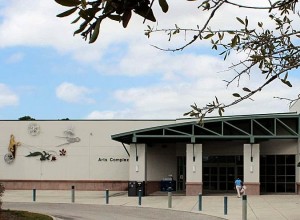 On the east wall of the Arts Complex is a highly symbolic sculpture titled The Dream to Connect. The overall composition is circular in format to mirror the cyclical nature of time and education. The focal point of the installation is the Greek god Apollo standing in a chariot that is borne by a wheel in the form of a metal gear. In Apollo’s hands are reins that are tied to a Silver Dollar
On the east wall of the Arts Complex is a highly symbolic sculpture titled The Dream to Connect. The overall composition is circular in format to mirror the cyclical nature of time and education. The focal point of the installation is the Greek god Apollo standing in a chariot that is borne by a wheel in the form of a metal gear. In Apollo’s hands are reins that are tied to a Silver Dollar 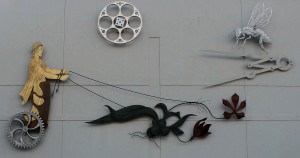 Orchid, an endangered epiphytic orchid found in the salt marshes and mangrove forest of Everglades National Park. Above and to the right of the orchid is a honey bee preparing to alight on a compass, and above and to the left of that is a stainless steel film reel.
Orchid, an endangered epiphytic orchid found in the salt marshes and mangrove forest of Everglades National Park. Above and to the right of the orchid is a honey bee preparing to alight on a compass, and above and to the left of that is a stainless steel film reel.
Apollo
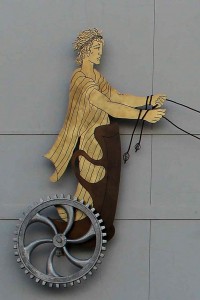 Apollo is the Greek god of the arts and patron of intellectual pursuits. Cast in brass, this mythological figure reflects a period of civilization that refined aesthetic and technical benchmarks and embodied classical standards of education, civilization and Olympian ideals. His rule as leader of the muses establishes him as a source of inspiration, as does his name’s connection with U.S. space exploration. “I liked the association to the Apollo moon mission, which is firmly connected with Florida and resulted in greater understanding of the Earth and moon,” says Dream to Connect sculptor, artist, and FGCU art educator Mary Sullivan Voytek.
Apollo is the Greek god of the arts and patron of intellectual pursuits. Cast in brass, this mythological figure reflects a period of civilization that refined aesthetic and technical benchmarks and embodied classical standards of education, civilization and Olympian ideals. His rule as leader of the muses establishes him as a source of inspiration, as does his name’s connection with U.S. space exploration. “I liked the association to the Apollo moon mission, which is firmly connected with Florida and resulted in greater understanding of the Earth and moon,” says Dream to Connect sculptor, artist, and FGCU art educator Mary Sullivan Voytek.
Silver Dollar Orchid
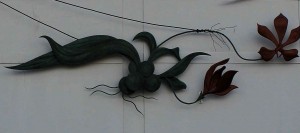 “I wanted to have an element in the sculpture that speaks to FGCU’s environmental mission, one that also reflected a broader association to Southwest Florida’s native beauty,” Voytek expounds. The Silver Dollar Orchid is not only native to
“I wanted to have an element in the sculpture that speaks to FGCU’s environmental mission, one that also reflected a broader association to Southwest Florida’s native beauty,” Voytek expounds. The Silver Dollar Orchid is not only native to 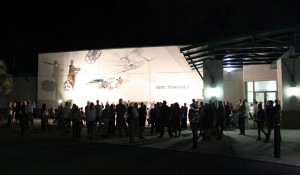 Southwest Florida, it is on the endangered species list along with the more famous Ghost Orchid. It is commonly called Silver Dollar Orchid because of the round pseudo bulbs that have silvery papery coverings. The orchids were quite remarkable and highly prized. In fact, its natural beauty lured orchid thieves to Southwest Florida in the late 1800s. Thus, the orchid not only serves as a clarion call to conservation, but symbolizes the monetary significance of our natural landscape in Florida to the state’s economic well-being.
Southwest Florida, it is on the endangered species list along with the more famous Ghost Orchid. It is commonly called Silver Dollar Orchid because of the round pseudo bulbs that have silvery papery coverings. The orchids were quite remarkable and highly prized. In fact, its natural beauty lured orchid thieves to Southwest Florida in the late 1800s. Thus, the orchid not only serves as a clarion call to conservation, but symbolizes the monetary significance of our natural landscape in Florida to the state’s economic well-being.
Honeybee
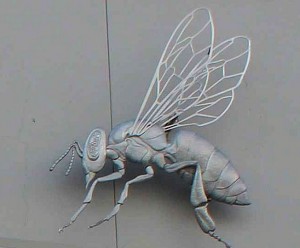 “On a symbolic level,” Voytek notes, “the bee is richly imbued. It exemplifies collective productivity; it is capable of sensing ultraviolet light unseen by humans. Its calling to pollinate is not unlike the mission of the artist to collect and influence the blossoming of ideas. Indeed, the bee performs myriad valuable functions, furnishing food in the form of honey – one of the earliest crops harvested by humans – and producing beeswax, which through the ages has been combined with resin and pigment, is utilized by artists working in the encaustic medium.” The honeybee has been used frequently throughout the annals of history to symbolize the exchange of ideas and the proliferation of thought and creativity. For example, the Medici family adopted the honeybee as their family symbol, often incorporating a carved bee into the frames of their art collection.
“On a symbolic level,” Voytek notes, “the bee is richly imbued. It exemplifies collective productivity; it is capable of sensing ultraviolet light unseen by humans. Its calling to pollinate is not unlike the mission of the artist to collect and influence the blossoming of ideas. Indeed, the bee performs myriad valuable functions, furnishing food in the form of honey – one of the earliest crops harvested by humans – and producing beeswax, which through the ages has been combined with resin and pigment, is utilized by artists working in the encaustic medium.” The honeybee has been used frequently throughout the annals of history to symbolize the exchange of ideas and the proliferation of thought and creativity. For example, the Medici family adopted the honeybee as their family symbol, often incorporating a carved bee into the frames of their art collection.
Compass
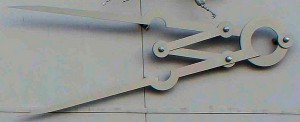 The compass is a universal tool for artists, engineers, scientists and mathematicians, and one that is likely to be used within the Arts Complex. Designed by Leonardo da Vinci, it epitomizes the Renaissance’s humanist ideals and
The compass is a universal tool for artists, engineers, scientists and mathematicians, and one that is likely to be used within the Arts Complex. Designed by Leonardo da Vinci, it epitomizes the Renaissance’s humanist ideals and 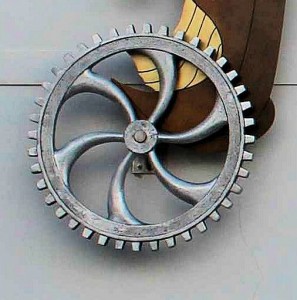 can be seen as linking many disciplines including art, architecture, engineering and mathematics.
can be seen as linking many disciplines including art, architecture, engineering and mathematics.
Gear
The gear is central to the history of industrialization and modernization while also implying the progressive nature of invention and technology. It suggests movement, especially circular – a motif that runs throughout this sculpture – as well as interdependence and cooperation, ideals inherent in campus life.
Film Reel
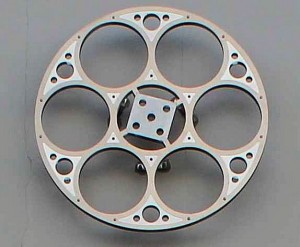 An icon of circular movement, the film reel grounds the sculpture in contemporary modern art and encourages the notion of accessibility. On a literal level, it denotes the Art Complex as a gathering place for film screenings in the future.
An icon of circular movement, the film reel grounds the sculpture in contemporary modern art and encourages the notion of accessibility. On a literal level, it denotes the Art Complex as a gathering place for film screenings in the future.
Multi-Colored Neon Backlighting
Some the elements of the sculpture are backlit by neon, which is an electronically charged gas. This not only contributes a sense of energy and 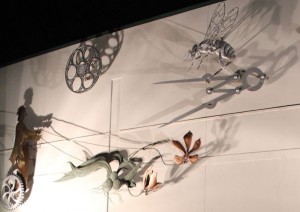 spectacle to the face of the Arts Complex, the glow of electrically charged gas against the reflective metal surfaces is a response to the characteristics of light experienced in Florida’s environment. “That light, combined with the ideals represented in this public sculpture,” adds Voytek, “will create a beacon to inspire students, faculty and visitors to Florida Gulf Coast University.”
spectacle to the face of the Arts Complex, the glow of electrically charged gas against the reflective metal surfaces is a response to the characteristics of light experienced in Florida’s environment. “That light, combined with the ideals represented in this public sculpture,” adds Voytek, “will create a beacon to inspire students, faculty and visitors to Florida Gulf Coast University.”
Overall Signification
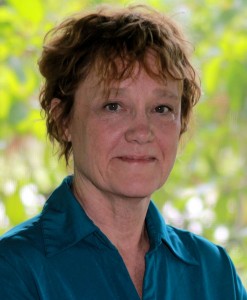 All of these icons work synergistically to convey connectivity. On a superficial level, the sculpture connects the face of the Arts Complex to the activities taking place inside. “But more than that, it connects the traditions of the arts to the future of the arts,” states Voytek. “It connects classic ideas with cutting-edge materials and techniques. It connects a variety of disciplines within the global arena of education. It connects and institution with its environment.”
All of these icons work synergistically to convey connectivity. On a superficial level, the sculpture connects the face of the Arts Complex to the activities taking place inside. “But more than that, it connects the traditions of the arts to the future of the arts,” states Voytek. “It connects classic ideas with cutting-edge materials and techniques. It connects a variety of disciplines within the global arena of education. It connects and institution with its environment.”
Circular Spatial Arrangement
The circular spatial arrangement of the six images included in the sculpture mirrors the unwavering, unending cyclical nature of time and education. “The compass is circular,” Voytek observes. “The film reel is circular. The gear would not function without connecting in a circular motion with another gear. The wheel gets us moving forward by moving forward by moving in a circular moiton. Education is also circular in the sense that what the students learn in one class builds and adds to the learning experience in another class. This circular motion continues even after leaving FGCU.”
Materials
Dream to Connect is made from a medley of media, including bronze, aluminum, titanium, stainless steel, copper and neon lights. Among the processes employed by Voytek in crafting the work are TIG welding, CAD cutting, bronze plating and aluminum sand casting. Finishes include powder coating, patination, and electronically grown titanium crystals.
Specifically, the portrait of Apollo is cast in brass. The orchid’s petals and sepals consist of hand-forged crystallized titanium, a purple-dappled gold metal that mirrors the plant’s actual colors. Incorporating state-of-the-art technology, the honey bee’s transparent aluminum wings were cut with a computer-controlled router to mimic the detailed web of tissue seen in nature. The gear and film reel are both aluminum.
Her Sculpture
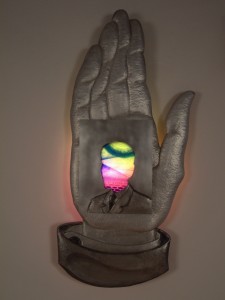 Voytek envisions and constructs sculpture that represents trace reminders of what has disappeared. Her work seeks deeper meaning and resonance in our lives by exploring our sense of belonging and relationship to the natural, spiritual and man-made worlds. “When successful, our inner space and outer space merge to become an undifferentiated mindful unified space,” Voytek reveals.
Voytek envisions and constructs sculpture that represents trace reminders of what has disappeared. Her work seeks deeper meaning and resonance in our lives by exploring our sense of belonging and relationship to the natural, spiritual and man-made worlds. “When successful, our inner space and outer space merge to become an undifferentiated mindful unified space,” Voytek reveals.
Voytek’s latest series of works has rekindled her love affair with nature, coming at a time of her life when she needed to focus on the beauty of simple truths. “Nature, even on its surface, tells the direct and simple truth of its existence,” says Voytek expansively. 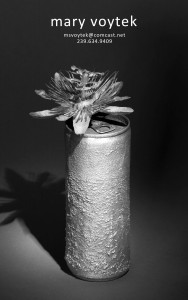 “The forms, colors and patterns certainly captivate me, but the excitement is in the dynamics of nature – its energy, growth, root systems, cellular structure, smells and shifts in light, form and color. These ephemeral aspects are what make my present life’s art a dedication to the glorious truth and freedom that is nature. I rejoice in sharing something so deeply rooted and exploring lines of continuity that point deep within our collective psyche.”
“The forms, colors and patterns certainly captivate me, but the excitement is in the dynamics of nature – its energy, growth, root systems, cellular structure, smells and shifts in light, form and color. These ephemeral aspects are what make my present life’s art a dedication to the glorious truth and freedom that is nature. I rejoice in sharing something so deeply rooted and exploring lines of continuity that point deep within our collective psyche.”
Voytek delivers her message through an exquisite combination of media, including aluminum, brass, bronze, copper, gold leaf, and brilliantly colorful neon lights. As Dream to Conquer illustrates, the artist also frequently appropriates images from mythology and the past, as well as 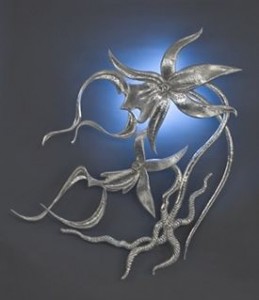 endangered species including the dollar orchid included in Dream to Conquer. “The inadequacy of language to deal with higher dimensionality or what was once called ‘a higher truth,’ or more recently referred to as ‘higher consciousness,’ calls on the arts to translate what the senses know but cannot say,” writes Voytek. By striking universal chords of remembrance and giving us access to past feelings, Voytek’s sculptures conjure a decidedly poignant sense of déjà vu that opens the viewer to the possibility of renewal and transformation of their own mythologies.
endangered species including the dollar orchid included in Dream to Conquer. “The inadequacy of language to deal with higher dimensionality or what was once called ‘a higher truth,’ or more recently referred to as ‘higher consciousness,’ calls on the arts to translate what the senses know but cannot say,” writes Voytek. By striking universal chords of remembrance and giving us access to past feelings, Voytek’s sculptures conjure a decidedly poignant sense of déjà vu that opens the viewer to the possibility of renewal and transformation of their own mythologies.
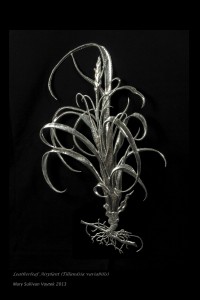 In particular, Mary has garnered worldwide attention and acclaim for her use of light as a medium in her sculpture. For example, her Tower series is constructed with bright neon encased in a polished, incised surface of stainless steel or aluminum. In this series, her use of light transforms the rigid, hard metals into a fluid, sculptural surface. Several of the works included in this series have been fabricated for display in outdoor venues.
In particular, Mary has garnered worldwide attention and acclaim for her use of light as a medium in her sculpture. For example, her Tower series is constructed with bright neon encased in a polished, incised surface of stainless steel or aluminum. In this series, her use of light transforms the rigid, hard metals into a fluid, sculptural surface. Several of the works included in this series have been fabricated for display in outdoor venues.
Mary has exhibited her work nationally, and internationally, including major galleries in San Francisco, Chicago, Miami, Santa Fe, Atlanta, and Washington, DC. Selected museum exhibitions include:
- Smithsonian Museum, Washington, DC
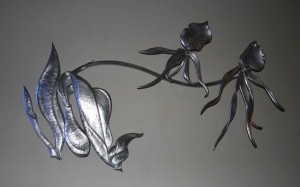 Berkshire Museum, Pittsfield, MA
Berkshire Museum, Pittsfield, MA- Museum of Contemporary Art, North Miami, FL
- Tampa Museum of Art, Tampa, FL
- Orlando Museum of Art, Orlando, FL
- Boca Museum of Art, Boca Raton, FL
- Hsinchu Museum of Cultural Arts, Hsinchu City, Taiwan
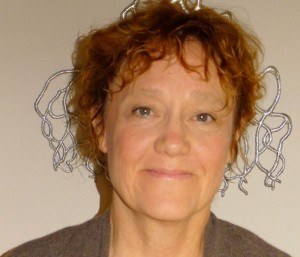 Selected public and private collections include:
Selected public and private collections include:
- Leo Castelli, New York
- Myra Daniels, Former CEO Naples Philharmonic, Naples, FL
- Paul Corddry, Former CEO Heinz Co., Boise, ID
- Richard Guggenheim, Cincinnati, OH
- Landmark Systems Corporate Headquarters, Washington, DC
- Greg Moyer, President, The Discovery Channel, Washington, DC
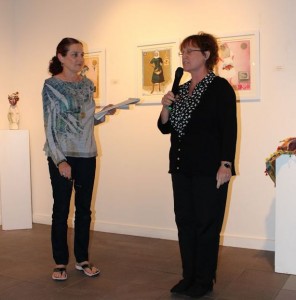 Robert Rauschenberg, Captiva, FL
Robert Rauschenberg, Captiva, FL- Sonesta Hotel, Boston, MA
- National Museum of Women in the Arts, Washington, DC
- Florida Gulf Coast University Library, Fort Myers, FL
In addition, her work was featured at the Glass Millennium Festival in Hsinchu City, Taiwan, where she exhibited an 18-foot neon and aluminum sculpture titled Buddha, which has since been exhibited in Los Angeles and is now on display at the Atlanta International Museum of Art & Design.
About Mary Sullivan Voytek
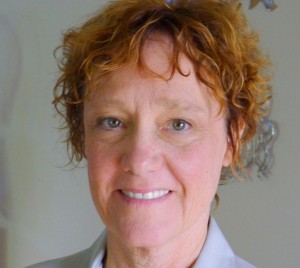 Mary Sullivan Voytek is an Associate Professor of Sculpture at Florida Gulf Coast University. She has an MFA from Rhode Island School of Design and a BFA from California College of the Art. She joined the faculty at FGCU in 2004. Prior to coming to FGCU she was a visiting instructor at Brown University and Rhode Island School of Design. Areas of special interest include environmental art, sculpture, and site-specific public art installation.
Mary Sullivan Voytek is an Associate Professor of Sculpture at Florida Gulf Coast University. She has an MFA from Rhode Island School of Design and a BFA from California College of the Art. She joined the faculty at FGCU in 2004. Prior to coming to FGCU she was a visiting instructor at Brown University and Rhode Island School of Design. Areas of special interest include environmental art, sculpture, and site-specific public art installation.
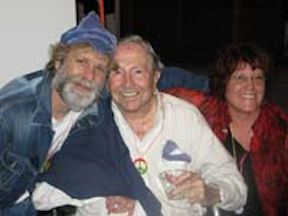 In addition to doing fabrications for Jim Dine, Mary was closely associated with Robert Rauschenberg for over 25 years. “Bob had a profound influence on my work, on the ways I see things,” Voytek said of the experience. “He was such a great artist and giving person that it was impossible to spend time around him and not be transformed in your visual thinking in some way.” Of course, Rauschenberg’s legacy not only includes the use of junk in his Combines and latter assemblages, but an experimental approach that stretched the boundaries of art for both present-day and future artists.
In addition to doing fabrications for Jim Dine, Mary was closely associated with Robert Rauschenberg for over 25 years. “Bob had a profound influence on my work, on the ways I see things,” Voytek said of the experience. “He was such a great artist and giving person that it was impossible to spend time around him and not be transformed in your visual thinking in some way.” Of course, Rauschenberg’s legacy not only includes the use of junk in his Combines and latter assemblages, but an experimental approach that stretched the boundaries of art for both present-day and future artists.
RELATED POSTS AND LINKS.
Mary Voytek’s ‘Motherboard’ full of mind-blowing metaphors and similes (06-17-17)
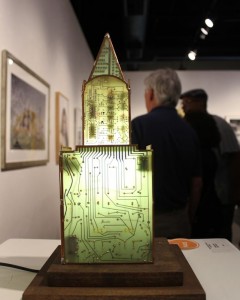 Artists from across Florida submitted more than 400 artworks for inclusion in the Alliance for the Arts’ 31st Annual All Florida Exhibition. Not only did FGCU Associate Professor of Sculpture Mary Voytek have her submission juried into the show, she was awarded second place by juror Kimberly Riner for her multi-metaphorical lighted sculpture titled Motherboard.
Artists from across Florida submitted more than 400 artworks for inclusion in the Alliance for the Arts’ 31st Annual All Florida Exhibition. Not only did FGCU Associate Professor of Sculpture Mary Voytek have her submission juried into the show, she was awarded second place by juror Kimberly Riner for her multi-metaphorical lighted sculpture titled Motherboard.
On one level, Motherboard gives the appearance of a cathedral or two-story house. “Many of my pieces incorporate the imagery of a house,” Voytek acknowledged during the opening night reception for the All Florida show. “It’s an archetypal 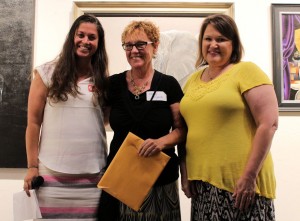 image I’ve worked with for over 30 years and is symbolic of our subconscious. Like your home, you store things in your subconscious. Now you might invite someone to come inside your mind or your home, but even if you do, there are things in drawers, closets and behind closed doors that you keep tucked away from public access. The house image really speaks to me, and it always has.”
image I’ve worked with for over 30 years and is symbolic of our subconscious. Like your home, you store things in your subconscious. Now you might invite someone to come inside your mind or your home, but even if you do, there are things in drawers, closets and behind closed doors that you keep tucked away from public access. The house image really speaks to me, and it always has.”
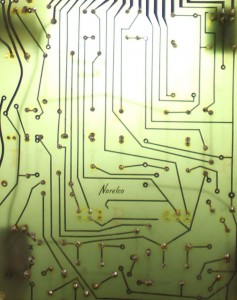 But Motherboard also represents the lines of communication that are taking place all over the world. “These are obviously circuit boards from old-fashioned computers,” Voytek points out, referring to the component pieces that she soldered together using stained glass copper coil for simplicity. “And just like mother earth or motherhood, the motherboard is at the core of communication. Through this technology, we meet people and fall in love. We share information about ourselves and each other. We purchase the things we need and the things we love.”
But Motherboard also represents the lines of communication that are taking place all over the world. “These are obviously circuit boards from old-fashioned computers,” Voytek points out, referring to the component pieces that she soldered together using stained glass copper coil for simplicity. “And just like mother earth or motherhood, the motherboard is at the core of communication. Through this technology, we meet people and fall in love. We share information about ourselves and each other. We purchase the things we need and the things we love.”
The printed circuit boards or PCBs that Voytek used in her sculpture are one sided, 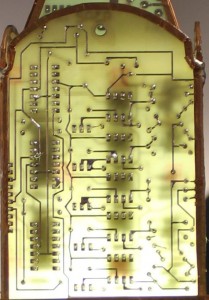 with copper traces, resistors, capacitors, inductors, diodes and switches installed on just the outer face. But just as we can be nuanced or multidimensional in how we process and relate information to others, it is also possible add a second layer of components on the reverse or flip side of a PCB or engraft additional layers over the original design. But in the latter case, the copper connections or traces cannot cross one another without the path of the electrical charge being compromised. And aren’t each of us continually assaying to keep our own wires from crossing as we add layers for more advanced thought and communications?
with copper traces, resistors, capacitors, inductors, diodes and switches installed on just the outer face. But just as we can be nuanced or multidimensional in how we process and relate information to others, it is also possible add a second layer of components on the reverse or flip side of a PCB or engraft additional layers over the original design. But in the latter case, the copper connections or traces cannot cross one another without the path of the electrical charge being compromised. And aren’t each of us continually assaying to keep our own wires from crossing as we add layers for more advanced thought and communications?
But Voytek’s symbolism does not end there. The copper traces of her PCBs are 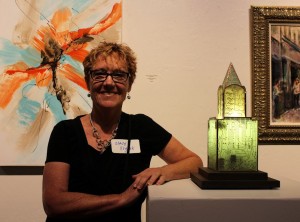 akin to its skeleton. The resistors, capacitors, and other components are tantamount to each board’s vital organs. Each has a different function. Individually and in the aggregate, they give the circuit board its uniquely individualistic qualities. Following the simile, our minds are comprised of thousands of thoughts, and just as thoughts are things, what we think and how we
akin to its skeleton. The resistors, capacitors, and other components are tantamount to each board’s vital organs. Each has a different function. Individually and in the aggregate, they give the circuit board its uniquely individualistic qualities. Following the simile, our minds are comprised of thousands of thoughts, and just as thoughts are things, what we think and how we 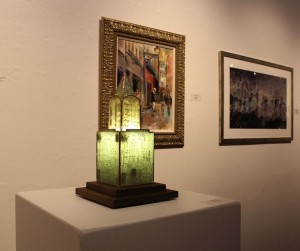 organize our thoughts is what makes us unique, different and separate from each other.
organize our thoughts is what makes us unique, different and separate from each other.
Don’t overlook the importance of the solder either. Components are attached to a PCB by solder. Any stray blobs that are out of place or which touch each other can cause the circuit to fail. Similarly, should one of Voytek’s solders fail, the entire motherboard could come apart or disintegrate.
“I enjoy this material because when you put a light behind it, it 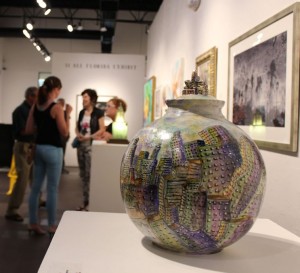 looks like jade,” Voytek comments, referring to the soldermask that gives a PCB its recognizable green coloration. In the case of the sculpture, its simultaneously translucent and opaque, much like ourselves and everyone we encounter.
looks like jade,” Voytek comments, referring to the soldermask that gives a PCB its recognizable green coloration. In the case of the sculpture, its simultaneously translucent and opaque, much like ourselves and everyone we encounter.
“I love walking at night and looking inside the windows of the houses I pass,” Mary adds. No, she not a peeping Thomasina. She is just fascinated by what’s happening behind the glow emanating from 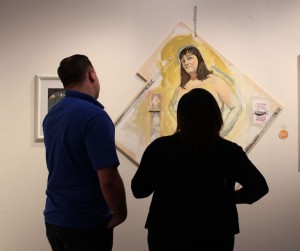 the glass. Sometimes, it seems to oscillate from a television or a person’s movement. At other times, it shines steady and bright.
the glass. Sometimes, it seems to oscillate from a television or a person’s movement. At other times, it shines steady and bright.
“The house is nothing without the people inside,” she muses. True that, otherwise you just have an empty structure in which the lights are on, but no one’s home.
Mary Sullivan Voytek is an Associate Professor of Sculpture at Florida Gulf Coast University. She has an 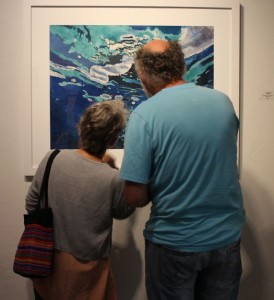 MFA from Rhode Island School of Design and a BFA from California College of the Art. She joined the faculty at FGCU in 2004. Prior to coming to FGCU she was a visiting instructor at Brown University and Rhode Island School of Design. Areas of special interest include environmental art, sculpture, and site-specific public art installation.
MFA from Rhode Island School of Design and a BFA from California College of the Art. She joined the faculty at FGCU in 2004. Prior to coming to FGCU she was a visiting instructor at Brown University and Rhode Island School of Design. Areas of special interest include environmental art, sculpture, and site-specific public art installation.
In addition to doing fabrications for Jim Dine, Mary was closely associated with Robert Rauschenberg for over 25 years. “Bob had a profound influence on my work, on the ways I see things,” Voytek said of the experience. “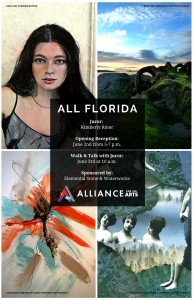 He was such a great artist and giving person that it was impossible to spend time around him and not be transformed in your visual thinking in some way.” Of course, Rauschenberg’s legacy not only includes the use of junk in his Combines and latter assemblages, but an experimental approach that stretched the boundaries of art for both present-day and future artists.
He was such a great artist and giving person that it was impossible to spend time around him and not be transformed in your visual thinking in some way.” Of course, Rauschenberg’s legacy not only includes the use of junk in his Combines and latter assemblages, but an experimental approach that stretched the boundaries of art for both present-day and future artists.
The Alliance’s 31st Annual All Florida Juried Exhibition will be on view in the main gallery through June 30.
The Alliance for the Arts is located on a ten-acre campus at the corner of Colonial and McGregor Boulevards. For GPS purposes, the address is 10091 McGregor Blvd., Fort Myers, FL 33919.
For more information, call 239-939-2787 or visit www.ArtInLee.org.














 Tom Hall is both an amateur artist and aspiring novelist who writes art quest thrillers. He is in the final stages of completing his debut novel titled "Art Detective," a story that fictionalizes the discovery of the fabled billion-dollar Impressionist collection of Parisian art dealer Josse Bernheim-Jeune, thought by many to have perished during World War II when the collection's hiding place, Castle de Rastignac in southern France, was destroyed by the Wehrmacht in reprisal for attacks made by members of the Resistance operating in the area. A former tax attorney, Tom holds a bachelor's degree as well as both a juris doctorate and masters of laws in taxation from the University of Florida. Tom lives in Estero, Florida with his fiancee, Connie, and their four cats.
Tom Hall is both an amateur artist and aspiring novelist who writes art quest thrillers. He is in the final stages of completing his debut novel titled "Art Detective," a story that fictionalizes the discovery of the fabled billion-dollar Impressionist collection of Parisian art dealer Josse Bernheim-Jeune, thought by many to have perished during World War II when the collection's hiding place, Castle de Rastignac in southern France, was destroyed by the Wehrmacht in reprisal for attacks made by members of the Resistance operating in the area. A former tax attorney, Tom holds a bachelor's degree as well as both a juris doctorate and masters of laws in taxation from the University of Florida. Tom lives in Estero, Florida with his fiancee, Connie, and their four cats.